The title of the paper is High predation of marine turtle hatchlings near a coastal jetty and is currently in press (accepted for publication but has yet to be published in a volume or issue) in the journal of Biological Conservation. I met the first author Phillipa Wilson last year at a symposium where all the work or research on flatback sea turtles (Natator depressus) happening in the northwest shelf of Australia was being presented (mine included). She gave a presentation about this paper when she was writing it up as a chapter for her PhD thesis, and suffice to say it was really interesting when I first heard it.
A Bit Of Background…
Before I get into this paper, there is some interesting history to it. Phillipa had initially set out to study the effect lights on a jetty were having on flatback sea turtle hatchlings as they were leaving the beach to open ocean. They found an unused 90-m long jetty on the southeastern end of Thenevard Island and put lights on it, and then placed acoustic receivers in the water in a grid pattern at varying distances from the jetty. They attached some acoustic tags onto the bottom of some hatchlings and released them from the beach to swim over the acoustic receivers. The acoustic receivers recorded where the hatchlings were moving as they swam over the receivers, and since each acoustic tag had a specific code, they were able to map out the trails the hatchlings took over the nearshore habitat. During different times each night, they would turn the lights they placed on the jetty on or off and note the swimming behavior of the hatchlings (i.e. were they swimming toward the lights or away from the lights).
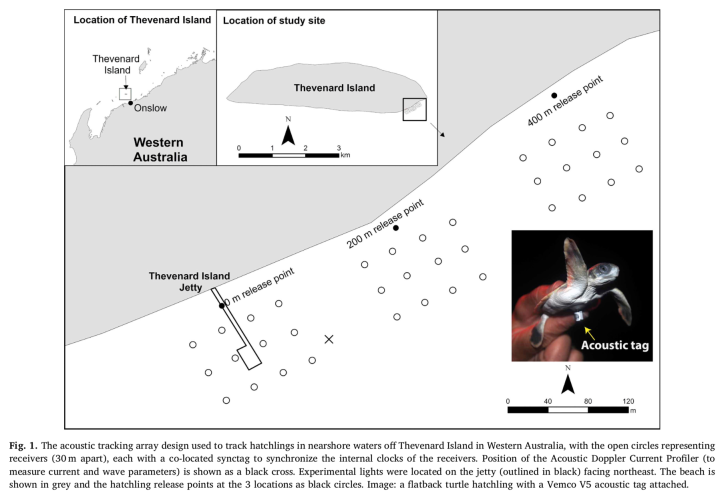
The plan was to essentially reproduce a study from 2016 by Michele Thums and her colleagues, who found sea turtle hatchlings were heading towards lights that were on the water. The difference between Phillipa’s and Michele’s study was the placements of the lights, which were on the jetty. Such findings would be important, especially for busy ports. There have been tons of studies about how sea turtle hatchlings get misorientated by lights that are behind the beach, with many sea turtles heading inland rather than out to sea. What the 2018 study showed is that if hatchlings manage to get into the water, they still have to contend with lights that happen to be on the water.
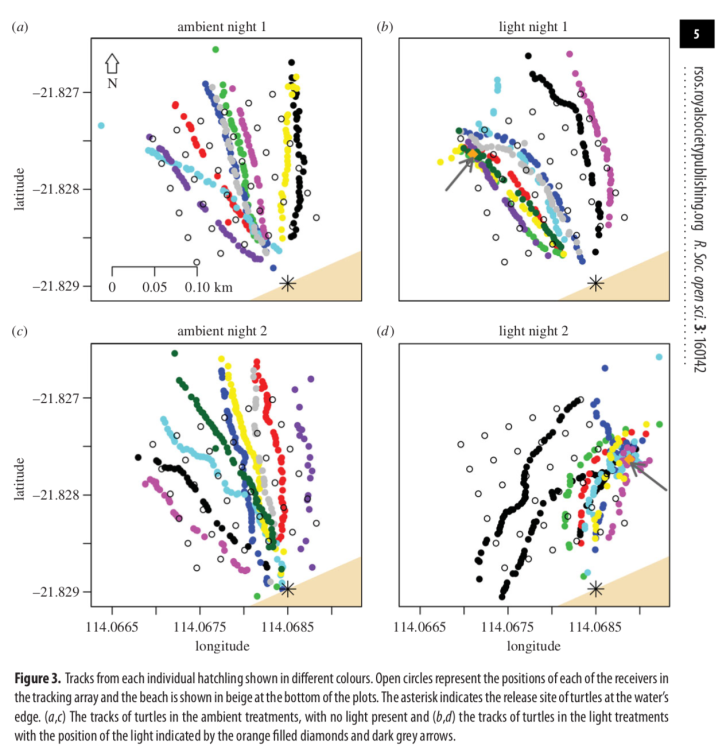
Back to the current study: when Phillipa went to collect the acoustic receivers and download the data, the swimming behavior was not what she expected. Some tracklines showed the sea turtles moving out towards open ocean, but some looked like they swam for a few meters and then began moving parallel to the beach, back and forth, very quickly.
What she was seeing weren’t tracks of sea turtles. Or rather, to put it more precisely, they were not tracks of sea turtle hatchlings on their own. These hatchlings got eaten. In fact, 70% of Phillipa’s sea turtle hatchlings (44 individuals) got eaten by predators. The tracks she was watching are of the hatchlings, but are of the hatchlings in the stomach of the predators.
So, what does a PhD student do when a massive chunk of their sample gets munched on? Change the objective of their chapter. Thus, the chapter changed from the effects of jetty lights on hatchlings to predation of hatchlings next to a jetty.
That is one of my favourite recoveries from a stuffed up experiment.
So…What Did They Find?
Of the 44 sea turtles that got munched, 21 tags had detached from the hatchling when they got nabbed by a predator (in other words, the big fish didn’t manage to swallow the tag), while 23 managed to get swallowed. For the tags that got swallowed, it looked like the attack on the hatchlings occurred very close to shore, meaning the hatchlings didn’t have a chance to get very far before they got picked off by predators.
It gets way more interesting.
In a study published in 2018, Phillipa conducted the same experiment on the northwestern side of Thenevard Island, where the hatchlings entered the water near a natural reef. They shone a light from a boat moored on the western side of the acoustic receivers to see if they would swim towards them, but also turned the lights off during parts of the experiment so they could compare their swimming behavior. When the lights were off in both the 2018 and 2019 paper, the experiment in the southeastern corner of Thenevard Island (2019 paper) had substantially higher predation rates than the one in the northwest corner, by as much as nearly 50%. In fact, Phillipa’s 2019 study had one of the highest predation rates of hatchlings for studies of its kind.
Both the northwestern and southeastern corners of Thenevard Island are important nesting sites for sea turtles, which means a lot of hatchlings will enter the water from those sites as well. Given that fish predators will swim to areas that are known to have a lot of prey, why was the southeastern side getting a lot more predation than the northwestern side when there are loads of hatchlings entering the water?
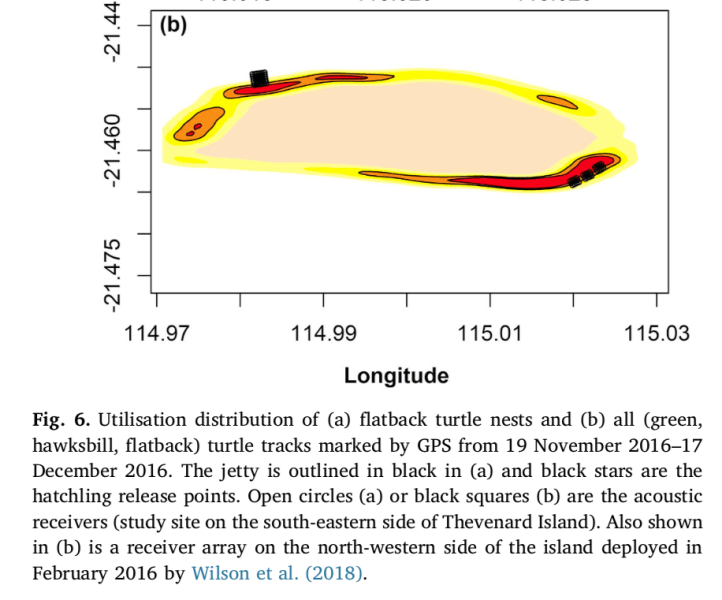
The only difference between the two sites was the presence of the jetty in the southeastern corner. They placed cameras in the water around the jetty and found loads of large predatory fish hiding there, most of which were mangrove jacks (Lutjanus argentimaculatus). When they cut open the guts of a mangrove jack caught by a fisherman, they had found two whole flatback sea turtle hatchlings! This was hard evidence that the fish sheltering at the jetty were predating on the hatchilngs entering the water.
Because the predators had also swallowed the acoustic tags when they ate the hatchlings, Phillipa was able to look at where the predators were moving around. During the day time, the predators were mostly taking shelter around the jetty. But at night, the predators came out to play. They swam parallel to the beach, back and forth, patrolling the nearshore habitat waiting for the hatchlings to come.
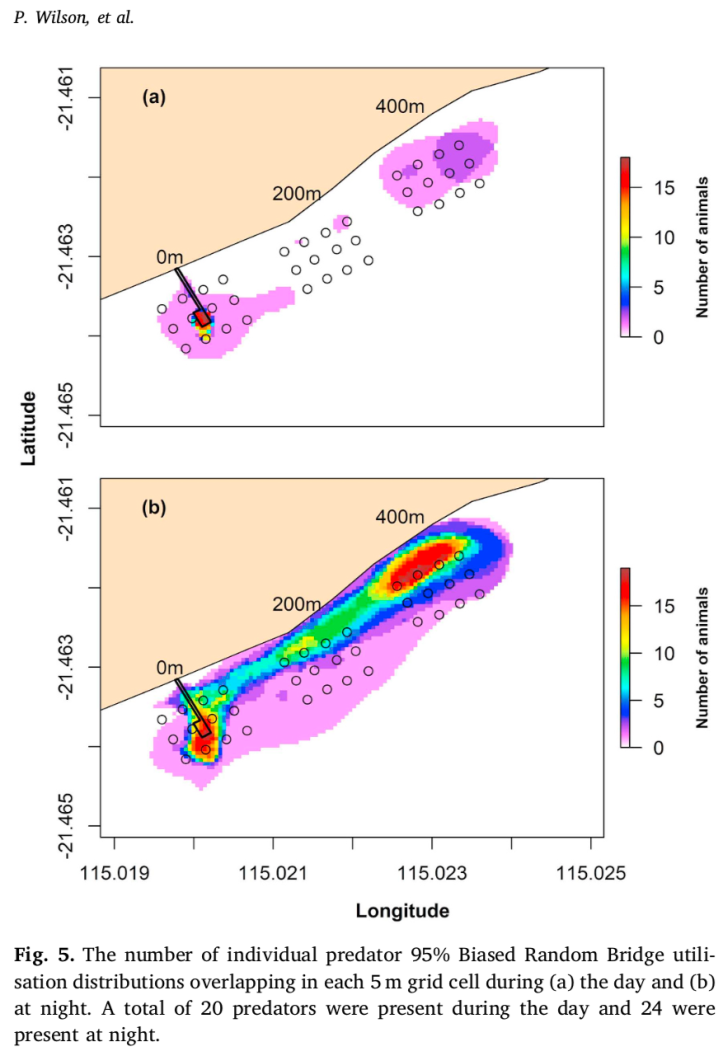
This is a big deal. No other study had measured the predation of hatchlings near human-made structures before, so Phillipa and colleagues had essentially broke new ground for the field of sea turtle biology and ecology. But now that they measured it, the results are gut-wrenching. Fish are known to take shelter in places that have a lot of surface complexity, such as coral reefs, but they have a particular liking to human-made structures like jetties, wharves, groynes, and docks. Considering the fact that the world is chock full of these structures, you can begin to imagine the impacts they’re having on nesting populations.
What Are The Implications?
Singapore has a lot of light along the coast. East Coast Park, a public park that stretches 15 km along the Singapore coast, is one such place. This park also happen to be (so far) the known hot-spots for sea turtle nesting in Singapore (mostly because the public are always there and report them, so if they’re nesting elsewhere, it’s not known). In 2006, hawksbill sea turtle hatchlings that hatched on East Coast Park headed inland as they ended up following the lights within the park. They were given a helping hand to return to the ocean, but even then, ships off the coast of Singapore had their lights shining bright in the night.
It’s not just a few ships, though. It’s hundreds of ships (see below). Imagine all those ships being lit up at night; it’d be nearly impossible for a sea turtle hatchling to get through with all their lights on.
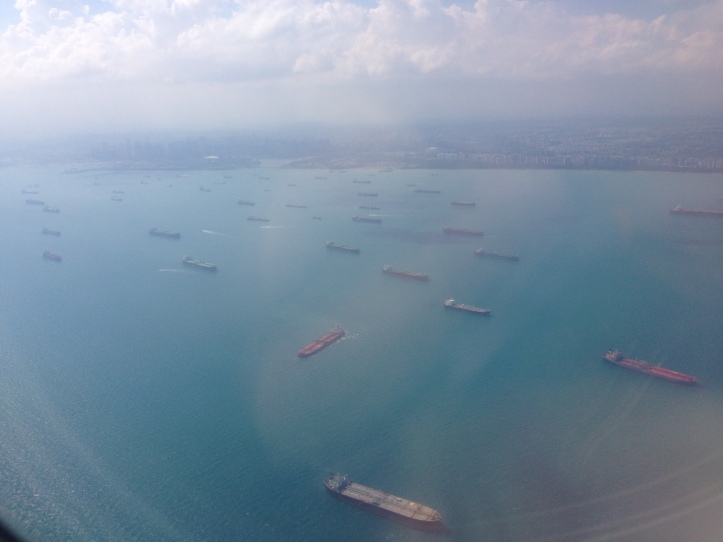
The findings from Phillipa’s study could now mean the sea turtle hatchlings that originate from Singapore beaches are probably in more trouble than previously thought. It’s well known that much of Singapore coastline has been reclaimed, with human-made structures dotted everywhere along the coast. It’s quite possible that predatory fish could be lurking within these habitats, and given that predators would know where prey might be, they could either go to the Singapore shore for an easy hatchling snack or they could head out to the ships and just wait at the ships for the hatchling buffet.
Singapore is just an example I illustrate because I’m somewhat familiar with the environment, but it is one of many places around the world where human-made structures are prevalent, particularly around the tropics and within a stones-throw of important nesting habitats. Given how important this life history stage is for sea turtles, I sincerely hope that managers and policy makers will do things to ensure these charismatic marine creatures will persist into the future.
Studies Mentioned
- Lai, S., Loke, L.H.L., Hilton, M.J., Bouma, T.J., Todd, P.A., 2015. The effects of urbanisation on coastal habitats and the potential for ecological engineering: A Singapore case study. Ocean Coast. Manag. 103, 78–85. DOI: 10.1016/j.ocecoaman.2014.11.006
- Thums, M., Whiting, S.D., Reisser, J., Pendoley, K.L., Pattiaratchi, C.B., Proietti, M., Hetzel, Y., Fisher, R., Meekan, M.G., 2016. Artificial light on water attracts turtle hatchlings during their near shore transit. R. Soc. Open Sci. 3, 160142. DOI: 10.1098/rsos.160142
- Wilson, P., Thums, M., Pattiaratchi, C., Meekan, M., Pendoley, K., Fisher, R., Whiting, S., 2018. Artificial light disrupts the nearshore dispersal of neonate flatback turtles Natator depressus. Mar. Ecol. Prog. Ser. 600, 179–192. DOI: 10.3354/meps12649
- Wilson, P., Thums, M., Pattiaratchi, C., Whiting, S., Pendoley, K., Ferreira, L.C., Meekan, M., 2019. High predation of marine turtle hatchlings near a coastal jetty. Biol. Conserv. S0006320718318925. DOI: 10.1016/j.biocon.2019.04.015
[…] first post in the series will be on a paper based on a presentation I saw at a symposium on how hatchling sea turtles are […]
LikeLike
[…] number two for Sea Turtle Paper of the Month! Last month I talked about how predators near a human-made structure (pier) would rush rush out and eat […]
LikeLike